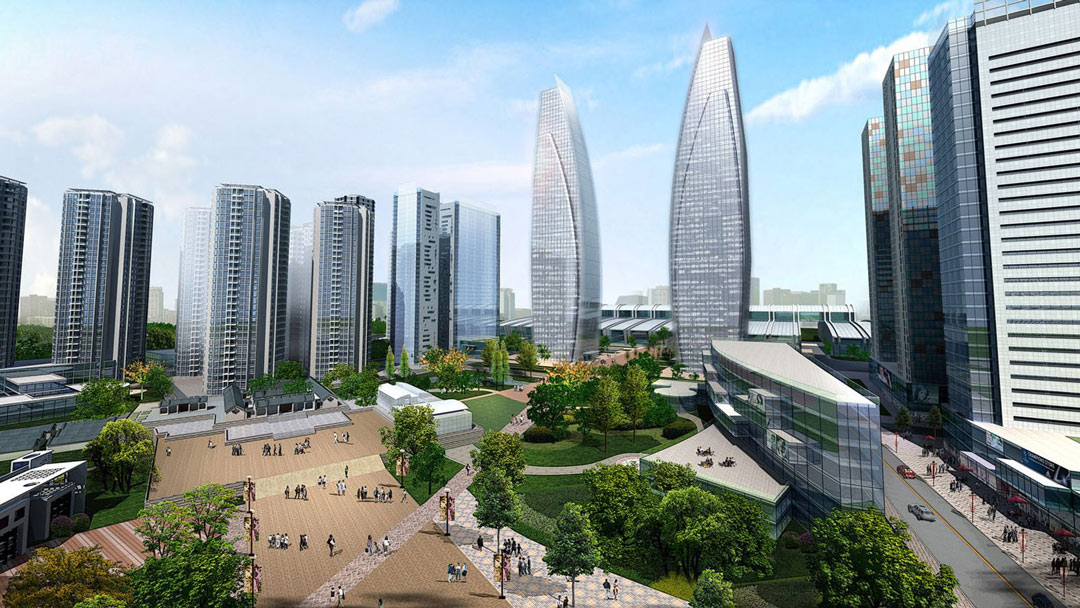Recent Articles
How will quality of life in cities change post-pandemic?
Urbanist Chia-Lung Chang, AIA, sees long-term public-health and livability benefits as we adapt to a new normal

COVID-19 has changed so much about how cities operate. Some of these changes will pass quickly, while others will leave a permanent mark. To understand out how urban life might change in the long term, LEO A DALY’s Commercial Market Sector Leader Kristina Crawley, AIA, NCARB, LEED AP, sat down with Chia-Lung Chang, AIA, our director of planning and urban design, over Zoom.
(The following is an edited excerpt of a panel discussion that also featured Chief Sustainability Officer Ellen Mitchell-Kozack. To read Ellen’s half of the conversation, click here.)
The pandemic made all of us more aware of the potential health impacts of urban density. As a planner and architect, how do you see cities maintaining and even improving quality of life post-pandemic?
One of the biggest trends of the last half-century has been accelerating urbanization worldwide. As a species, we’ve elected to migrate to cities in search of a certain quality of life – more choices, different types of lifestyles, better mobility, services, the ability to grow personally and professionally, and the ability to earn and support our families in a safe environment.
I don’t think we’re going to see a massive reversal of urbanization after COVID-19. Urban areas account for 80 percent of the world’s GDP, and I believe we will continue to migrate to where the opportunities are. I think what we’re seeing, and what we will continue to see, is a range of adaptations taking root as we find better, safer ways of living in cities.
From the perspective of public health, how do you see U.S. cities adapting?
There will be short– and long-term effects to COVID-19. In the short term, people are going to be more concerned about safety, cleanliness and proximity to people.
In the longer term, it’s helpful to look at how a place like Taiwan changed as a result of a previous pandemic, SARS. Taiwan was hard hit by SARS, but that experience gave them a head start in preparing for COVID-19. As soon as the disease started to spread, they were able to use social media to get information out to the public, immediately began ramping up production of personal protective equipment (PPE), and created a website for making sure everyone who needed PPE got it. As a society, they have dealt with it very well, and their infection numbers have been below the norm as a result.
One thing I know for sure is that people are very resilient. Like Taiwan, the U.S. will emerge from this pandemic with a new perspective on public health, and new ways of addressing threats in terms of policy, culture and the built environment.
A couple weeks ago, Lauren Funk blogged about how much cleaner our air and water have become since the lockdown started, how have less traffic congestion, etc. Do you see these becoming long–term changes moving forward?
Work-from-home and remote learning have the biggest potential for long-term impact. Not only have we seen environmental benefits, but there’s also suddenly a new quality of life for our families. We get to see each other more throughout the week, and that’s just a feature of life that hasn’t been part of most urbanized societies for a long time. I would imagine this is a benefit that will remain in some form going forward.
Of course, the “work anywhere” model has been out there already in many government agencies and private sector businesses for a while, but that attitude will be much more prevalent after the pandemic.
If everyone stayed home even one day a week, we could save, theoretically, 20 percent of the carbon output associated with commuting to work. And there’s a domino effect. With less travel, urban planners will be free to rethink road networks. It would open up new opportunities for placemaking and returning roadways to pedestrians, which is a great way to improve quality of life in dense urban areas. All these things play into each other.
Great point. That reminds me of National Parking Day, which is when guerilla urbanists take over parking spots on major commuter routes and create little urban oases to show how streets could become more vibrant. We’re beginning to see road closures in some places because of the reduction in commuter traffic, which makes more room for people to walk and to exercise and to bike. That’s sort of the utopian dream for any urbanist or architect. I think those are the things we don’t want to give up – those positive effects that we’ve seen: more people outside, more vibrant streets, people reclaiming areas where vehicles once were.
Absolutely. One thing that DC Mayor Murial Bowser has done – because some people were walking in the street to observe physical distancing – was to widen the pedestrian right of way so that people would be protected from cars. That is the kind of thing that, if retained for the long term, would improve quality of life. As planners, we want to create a walkable, more pedestrian-friendly, enjoyable environment. That extra bit of separation from the vehicular traffic, if it were made permanent, could be put back into green space, could continue to benefit our environment, could continue to contribute to quality of life down the line.

Chia-Lung Chang, AIA, is LEO A DALY’s director of planning and urban design. He works closely with executive and studio leadership to develop and execute strategic direction for our global planning and urban design practice. An award-winning planner and architect, Chia is widely recognized for the forward-looking leadership he brings to his work and regularly lectures on smart cities, quality of life and long-term sustainability in the built environment.

Kristina Crawley has nearly 16 years of experience in commercial mixed-use, hospitality, retail, restaurant and workplace design in the United States and abroad, including commercial and mixed-use projects from Shanghai to South Korea to Dubai. With a passion for contextual design and placemaking, Kristina has published several articles on resilience, international architectural responses to climate change and post-disaster reconstruction.
